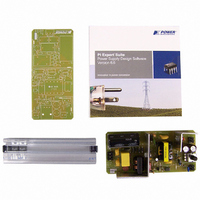RDK-128 Power Integrations, RDK-128 Datasheet - Page 6

RDK-128
Manufacturer Part Number
RDK-128
Description
KIT REF DESIGN 36-72W MOTOR DRVR
Manufacturer
Power Integrations
Specifications of RDK-128
Main Purpose
Power Management, Motor Control
Embedded
No
Utilized Ic / Part
PKS606
Primary Attributes
Variable Speed 12V 36W DC Motor, 90 ~ 265 VAC
Secondary Attributes
External Potentiometer or Variable DC Voltage Speed Control
Lead Free Status / RoHS Status
Not applicable / Not applicable
Other names
596-1198
of a PeakSwitch design are constant, the power delivered
to the load is proportional to the primary inductance of the
transformer and peak primary current squared. Hence, designing
the supply involves calculating the primary inductance of the
transformer for the maximum output power required. If the
chosen PeakSwitch family member is appropriate for the power
level, the current in the calculated inductance will ramp up to
current limit before the DC
Enable Function
PeakSwitch senses the EN/UV pin to determine whether or not
to proceed with the next switching cycle as described earlier.
The sequence of cycles is used to determine the current limit.
Once a cycle is started, it always completes the cycle (even when
the EN/UV pin changes state half way through the cycle). This
operation results in a power supply in which the output voltage
ripple is determined by the output capacitor, amount of energy
per switch cycle and the delay of the feedback.
The EN/UV pin signal is produced on the secondary by
comparing the power supply output voltage with a reference
voltage. The EN/UV pin signal is high when the power supply
output voltage is less than the reference voltage.
In a typical implementation, the EN/UV pin is driven by an
optocoupler. The collector of the optocoupler transistor is
connected to the EN/UV pin and the emitter is connected to
the SOURCE pin. The optocoupler LED is connected in series
with a Zener diode across the DC output voltage to be regulated.
When the output voltage exceeds the target regulation voltage
level (optocoupler LED voltage drop plus Zener voltage), the
optocoupler LED will start to conduct, pulling the EN/UV pin
Figure 9. PeakSwitch Operation at Medium Loading.
Rev. I 02/07
6
V
CLOCK
D
I
DRAIN
DRAIN
MAX
V
EN
PKS603-607
MAX
limit is reached.
PI-2377-091100
Figure 10. PeakSwitch Operation at Very Light Loading.
low. The Zener diode can be replaced by a TL431 reference
circuit for improved accuracy.
ON/OFF Operation with Current-Limit State Machine
The internal clock of the PeakSwitch runs all the time. At the
beginning of each clock cycle, it samples the EN/UV pin to
decide whether or not to implement a switch cycle, and based
on the sequence of samples over multiple cycles, it determines
the appropriate current limit. At high loads, when the EN/UV
pin is high (less than 240 µA out of the pin), a switching cycle
with the full current limit occurs. A t lighter loads, when EN/UV
is high, a switching cycle with a reduced current limit occurs.
200
100
300
200
100
Figure 11. PeakSwitch Power Up with Optional External UV
0
5
0
0
V
I
CLOCK
0
D
DRAIN
DRAIN
MAX
V
EN
V
V
V
DC-INPUT
DRAIN
BYPASS
Resistor (4 MW) Connected to EN/UV Pin.
Time (ms)
5
PI-2661-072400
10




















